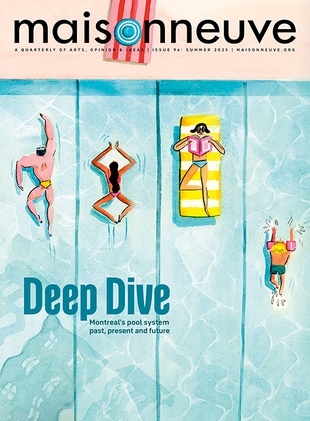The Book Room
The Syrian Ladies Benevolent Society
Contrary to its name, Christine Estima’s The Syrian Ladies Benevolent Society (House of Anansi) chronicles the history of six generations of a fictional Lebanese family in thirteen short stories. Each one offers the reader a fleeting glimpse into the life of a family member. We begin in 1860 in Lebanon, when Holwé Lutfeya flees her village with her six-month-old daughter, Hana, to escape persecution from the Druze, a religious group which was at war with Christians at the time. Fast-forward to 1930s Montreal, where Holwé’s grandson, Shafeek, has carved out a happy life with his family. Into the late twentieth and twenty-first century, the reader meets Shafeek’s grandchildren and great-grandchildren, and follows them as they undertake espionage, experience heartbreak and experiment with blood play in efforts to exorcise the ghosts of their pasts. Across the varying settings and time periods, what remains consistent is Estima’s detailed and evocative prose as she weaves a haunting tale of how the pain of loss—whether of our home, our loved ones or our sense of self—reverberates across generations. —Zeahaa Rehman
The Cliff
Two preteen girls—Astrid, a demure outcast, and Charlie, a notorious school bully frequently ridiculed for her gender-nonconforming appearance—make an unlikely pair of friends in the graphic novel The Cliff (Drawn & Quarterly). It might sound like the wholesome premise for a child-friendly tale about friendship, but author and illustrator Manon Debaye instead employs a dark twist: the story begins with the two girls swearing with a blood oath to jump off a cliff together on Charlie’s thirteenth birthday. We join Charlie in the week leading up to the date as she grapples with a burgeoning infatuation with Astrid and a reluctant friendship with the school’s pack of bullies, borne out of a desire for self-protection. While we’re less intimate with Astrid, we see her harassed by the bullies and hurt by Charlie’s apparent indifference. Ultimately, Charlie must make a choice: will she keep letting her friends bully Astrid, or rise above their petty violence? Quick enough to read in one sitting, this story is sure to sit with readers long after it’s over—especially for those who, like Charlie, spent their adolescence coming to terms with their gender expression and sexuality. —Abigail Popple
Big Mall: Shopping for Meaning
In Big Mall: Shopping for Meaning (Coach House Books), Kate Black invites us to consider the shopping mall as a mirror that reflects the peculiar conditions of the world that created it. Black walks us through how the retail institution’s role has changed alongside society, interspersing modern mall history with coming-of-age anecdotes of time spent in West Edmonton Mall, the largest in North America. Big Mall unpacks how the mall both deepens our relationship with consumerism and offers adolescents a space to grow up and reckon with their identities, the author included. What makes the mall special, and often an object of nostalgia, Black argues, is the human experience within it—lacking that, malls would be nothing but capsules of hollow, vacuous aesthetics. Through memoir, cultural criticism and a healthy dose of humour, Big Mall takes a deep dive into a robust pillar of modern consumerism, and is an ode to the role that malls play in shaping who we are. —Jeevan Sangha
Pervatory
No matter where you go, there you are.
Martin, the protagonist of the late RM Vaughan’s posthumously published novel Pervatory (Coach House Books), finds himself struck by this truism after he moves from Toronto to Berlin in his late forties. Hoping to escape the tiring calculus of social status and plunge into a city he sees as chiefly dedicated to “the maintenance of pleasure,” Martin revels in Berlin’s unsentimental culture, reigniting his carnal vitality as he frequents a slew of gay sex clubs; but his mind slowly starts to turn on him. The novel opens with Martin narrating from a psychiatric institution, trying to convince the reader of his sanity, and then quickly jumps back in time to follow him as he acquaints himself with Berlin and becomes infatuated with an inscrutable man equal parts tender and domineering. Vaughan deftly holds the book’s darker current at a distance, submerging it in a realist narrative of an art critic gone abroad, amusingly punctuated by sharp social commentary. The darkness only surfaces through sporadic moments of madness, haunted ruptures that reveal this story to be simultaneously about a person falling in love and about a person falling apart. —Noah Ciubotaru
States of Emergency
Reading Toronto poet Yoyo Comay’s debut collection, States of Emergency (Véhicule Press), is like feeling the churning, shifting mass of a living, breathing language envelop you. Split up into six parts, the writing within this book-length poem is visceral, fleshy and earthy to the point of occasionally being almost gross, grounded in an unstoppable ecstasy that isn’t an ecstasy of joy, nor of grief—of something less easily definable, entirely separate from the joy-grief axis. The sense of constant motion propels the reader through the poem with such force that they become a part of it, implicated in its flood of language. Beautiful lines rise up through the torrent: “reality is that / toward which the wave rushes, brushes then / scatters in retreat,” writes Comay; at another point, “I swallow metallic, pouring through moments.” At times the poem breaks away from itself for asides or reactions, as though the speaker is engaged in an active process of trying—and failing—to keep their voice restrained. Bizarre and breathtaking writing creates new meanings entirely, giving the impression that we don’t actually create language, but rather exist within it attempting to make sense of it—or, like in States of Emergency, allow it to take over completely and enjoy the rush of the fallout. —Nour Abi-Nakhoul





